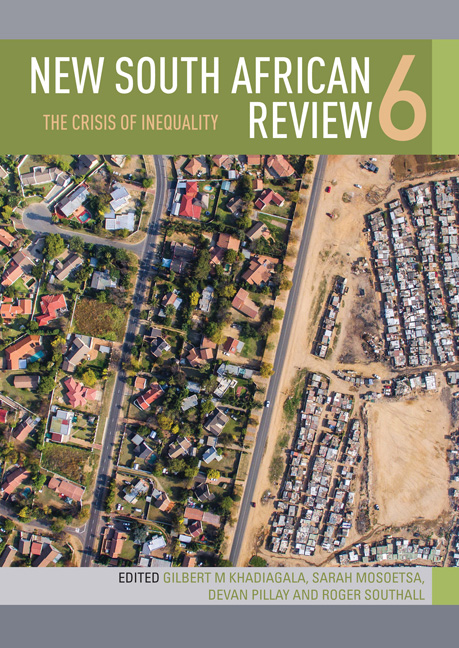Book contents
- Frontmatter
- Contents
- List of tables and figures
- INTRODUCTION: The global crisis of inequality and its South African manifestations
- PART 1 INEQUALITY AND CLASS: POLARITIES AND POLICIES
- CHAPTER 1 Inequality in South Africa
- CHAPTER 2 A national minimum wage in South Africa: A tool to reduce inequality?
- CHAPTER 3 The politics of poverty and inequality in South Africa: Connectivity, abjections and the problem of measurement
- CHAPTER 4 The financialisation of the poor and the reproduction of inequality
- PART 2 THE POLITICS OF INEQUALITY
- PART 3 SOCIAL DIMENSIONS OF INEQUALITY
- PART 4 LAND AND ENVIRONMENT
- Contributors
- Index
CHAPTER 4 - The financialisation of the poor and the reproduction of inequality
from PART 1 - INEQUALITY AND CLASS: POLARITIES AND POLICIES
Published online by Cambridge University Press: 23 March 2018
- Frontmatter
- Contents
- List of tables and figures
- INTRODUCTION: The global crisis of inequality and its South African manifestations
- PART 1 INEQUALITY AND CLASS: POLARITIES AND POLICIES
- CHAPTER 1 Inequality in South Africa
- CHAPTER 2 A national minimum wage in South Africa: A tool to reduce inequality?
- CHAPTER 3 The politics of poverty and inequality in South Africa: Connectivity, abjections and the problem of measurement
- CHAPTER 4 The financialisation of the poor and the reproduction of inequality
- PART 2 THE POLITICS OF INEQUALITY
- PART 3 SOCIAL DIMENSIONS OF INEQUALITY
- PART 4 LAND AND ENVIRONMENT
- Contributors
- Index
Summary
This chapter examines ‘financialisation’ and inequality in contemporary South Africa. An expansive and inconsistently used concept (Lee et al. 2009; Bracking 2015), ‘financialisation’ refers to ‘accumulation in which profits accrue primarily through financial channels rather than through trade and commodity production’ (Krippner 2005: 174). In the last three decades, the global ascendency of the financial sector has seen the proliferation of various finance-related motives, markets, actors and institutions (Epstein 2005), the emergence of highly speculative instruments (derivatives, futures and so on) and an expansion of debt and debt financing. The dynamics of financialisation are furthermore intertwined with larger trajectories of economic growth and their unequal distribution. In South Africa, processes of financialisation are inseparable from long-standing patterns of economic growth, integration into the global economy and the racially skewed distribution of assets, ownership and opportunity. The precise ways in which financialisation comes to articulate with inequality is the focus in this chapter.
The chapter begins by explicating the concept of financialisation and its relationship to inequality, which is discussed in relation to the historical development of the South African economy. The chapter argues that intensifying processes of financialisation serve to undercut the potential for broad-based and inclusive (that is, inequality reducing) growth. Processes of financialisation therefore not only reflect historical patterns of radicalised inequality – they simultaneously reproduce it. Drawing on this analysis, the chapter then examines financialisation in terms of its effects on households and individuals, particularly through the mechanism of indebtedness. Discussing the adverse developmental outcomes and inequality that indebtedness engenders, the chapter concludes with reflection on how financialisation resonates with contemporary policy imperatives, notably the development discourse of ‘financial inclusion’.
THE ANTECEDENTS OF FINANCIALISATION
Explanations of the process of financialisation conventionally locate it in the collapse of the post-war reconstruction boom, amid the global energy, currency and economic crises of the early 1970s. By this account, financialisation, market deregulation and privatisation are all adjuncts to the rise of neoliberalism, occurring in parallel with worldwide tendencies towards stagnating real wages, rising income inequality and declines in public provisioning and services. In turn, ‘financialisation’ has been used to describe an even wider range of phenomena, across an array of contexts, ranging from the imperative of maximising ‘shareholder value’ within contemporary regimes of corporate governance to the expanding role of finance in shaping identities and subjectivities, social and cultural life – even ecological decisions and priorities (Bracking 2015).
- Type
- Chapter
- Information
- New South African Review 6The Crisis of Inequality, pp. 84 - 100Publisher: Wits University PressPrint publication year: 2018



